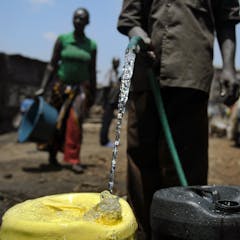
Articles on Solar energy
Displaying 1 - 20 of 134 articles

AI needs careful monitoring and the right policies to ensure it can benefit the fight against climate change.

California is considering a controversial proposal for utilities to charge customers for electricity based partly on household income. Two scholars explain how this approach could benefit everyone.

Solar development isn’t always good for the land, but pairing it with agriculture can produce multiple benefits.

Looking to go solar? While small-scale solar delivers the best results with the least life-cycle impact, a mixed approach offers the best long-term path towards an all-electric future.

Solar farms that span whole countries could change the climate – new study.

Of all Australia’s climate policies, the Renewable Energy Target has been the most effective. Why have Australian governments moved away from it, and how can they revive it?

The 1909 incident may have cost the industry decades of progress – and the planet huge amounts of damaging carbon emissions.

The demand for the minerals needed to build clean energy technology currently exceeds the available supply. If this issue continues, governments may find it hard to reach their clean energy targets.

Using agricultural land for both solar and food production presents huge opportunities for Canadian farmers, especially in Alberta.

There’s a consensus that extreme hydrological events will increase throughout the continent. This will lead to growing issues with power system reliability.

New research has found that bats avoid solar farms – but the findings should not hinder the transition to renewable energy.

Australia has a lot of wind and sun, but will we actually become a world leader in renewable energy generation?

China is a major investor in Latin America’s renewable energy and critical minerals like lithium, but countries like Chile are also taking steps to secure their own clean energy future.

A heater with a 300-litre tank can store as much energy as a home battery at a fraction of the cost. Being able to store surplus solar energy at the right times helps grid stability and cuts emissions.

Look for hidden trade-offs, political contributions and what businesses are not telling you.

Australia’s renewable energy transformation will require a huge amount of energy storage. We need Snowy 2.0 to succeed.

As the energy revolution gains pace, huge numbers of PV panels are already going to landfill. Many are still usable and even those that aren’t contain valuable materials that shouldn’t be discarded.

Canada can meet its carbon emission reduction targets, make food cheap again and open up a gigantic trade surplus with the U.S. by shading farm crops with solar panels.

Making the green energy transition a success requires governments to pay attention to environmental factors and socioeconomic imperatives.

Digital technology is changing the way water is accessed in Ghana. Water ATMs are gaining traction as a means to an end.





